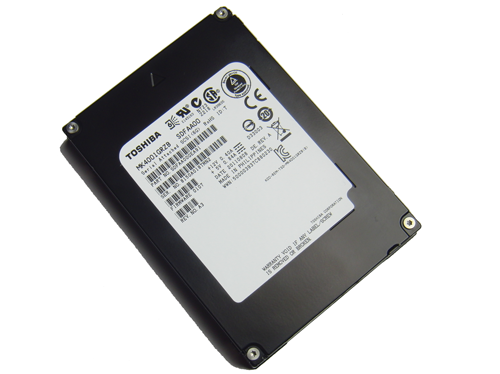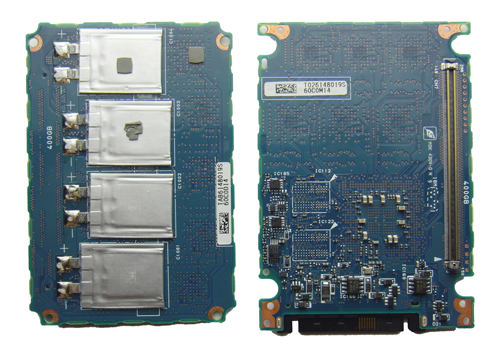Toshiba's $7000+ 400 GB SSD: SAS 6Gb/s, SLC Flash, And Big Endurance
Have you ever wondered what separates an enterprise SSD from a consumer-oriented drive? How about SLC and MLC flash (and a corresponding price gap)? We explore the differences with Toshiba's MK4001GRZB SSD, an obviously enterprise-oriented powerhouse.
Toshiba's SAS-Based Enterprise-Class SSD
Welcome to enterprise-class storage. The stakes are officially higher here. Although many large businesses continue to use conventional SAS-based hard drives, which are battle-tested in the most demanding environments, adoption of solid-state technology is picking up as the performance gains are just too significant to ignore. Transitioning to solid-state storage may seem like a daunting investment, but in applications where the random I/O of one or two SSDs can replace entire JBODs worth of short-stroked disks, they're often cheaper to buy and keep powered up.
In the desktop world, you have vendors bickering about who's using the best flash memory in their SSDs, and who's using the stuff scraped off of the foundry floor. But when you're talking about mission-critical servers, there is no room to compromise on reliability in the name of cheaper prices. Writing hundreds, if not thousands of terabytes of data necessitates eMLC- or SLC-based SSDs. And the number of vendors selling drives based on those classes of NAND can be counted on one hand.
Of course, just because there are fewer companies selling enterprise-oriented SSDs doesn't mean the competition isn't stiff. Big businesses buy drives in the thousands and are willing to pay a premium for hardware able to deliver high performance and reliability. For its part, Toshiba brings lots of experience in hard drives and NAND manufacturing to the table, giving it a unique perspective on what an enterprise-oriented SSD should be able to do.
That perspective is manifest in the company's flagship MKx001GRZB family of SSDs. Available in 100, 200, and 400 GB capacities, Toshiba arms its very high-end line-up with a couple of specifications you don't see every day (or hardly ever, really) from our desktop SSD reviews: 6 Gb/s SAS connectivity and SLC NAND.
| Toshiba MKx001GRZB Specifications | MK1001GRZB | MK2001GRZB | MK4001GRZB |
|---|---|---|---|
| RAW NAND | 128 GB | 256 GB | 512 GB |
| User Capacity | 100 GB | 200 GB | 400 GB |
| Interface | SAS 6Gb/s | ||
| Sector Size | 512, 520, 528 | ||
| Sequential Read | 500 MB/s | ||
| Sequential Write | 250 MB/s | ||
| 4 KB Random Read | 90 000 IOPS | ||
| 4 KB Random Write | 16 000 IOPS | ||
| Power Consumption (Active) | 6.5 Watts | ||
| Warranty | 5 Years |
Compared to what we're used to seeing from today's fastest desktop SSDs, Toshiba's MKx001GRZB line-up doesn't necessarily impress with its specified write performance. However, read speeds are roughly on par with the fastest SATA 6Gb/s MLC-based drives (that is to say, both interfaces are close to maxing out already). With regard to random read performance, specifically, it's rare to find an SSD that claims in excess of 80 000 IOPS. That Toshiba cites 90 000 is a downright impressive achievement.
In addition to its higher-end specs, the MKx001GRZB family doesn't look like your typical 2.5” SSD, either. It employs a 15 mm z-height, to begin, making it clear that the company is aiming to fit within the same form factor as current-generation 10 000 and 15 000 RPM 2.5" hard drives. That makes perfect sense, since businesses are increasingly shifting to that size in an effort to maximize density in the enterprise space.
Inside the larger enclosure, Toshiba sandwiches two PCBs together using a proprietary connector. On one board, you see Marvell's 88SS9032-BLN2 eight-channel SAS controller, on-board cache, and six SLC NAND devices; the other has ten SLC NAND devices along with four ultra-capacitors. In order to combat the thermal output of a more dense and complex design than what we're used to seeing in an SSD, each component is covered by a thermal pad able to shunt heat out toward the metal casing.
Get Tom's Hardware's best news and in-depth reviews, straight to your inbox.
We’re told that the whole product line features NAND manufactured using Toshiba’s 32 nm fab process, but since we’re testing the 400 GB model specifically, each NAND package on our sample presents 32 GB of raw capacity. Given 16 total packages, that gives us a total of 512 GB, translating to the standard 28% of overprovisioning commonly used for enterprise-class devices.
Current page: Toshiba's SAS-Based Enterprise-Class SSD
Next Page Endurance: Comparing MLC, eMLC, And SLC-
compton Good job, Mr. Ku.Reply
Perhaps the Enterprise SSD Fairy will bring you a Hitatchi UltraStar with Intel's 6gbps controller. I'd be eager to see how it compares.
There is no substitute for SLC though. -
bennaye nebun$7000 any company willing to pay this much for an SSD is fullishReply
...fullish of cash? Definitely. Foolish? Probably not.
-
nebun bennaye...fullish of cash? Definitely. Foolish? Probably not.damn the english language.....there are way to many words that sound alikeReply -
nitrium Why is the 4KB Random read/write performance shown as IOPS, but 128KB and 2MB performance is in MB/sec? What speed (in MB/sec) does this drive achieve in 4KB? I guess I could calculate it from (IOPS * 4KB) / 1024 (I think that's right), but why should I have to?Reply -
spazoid amdfreakIt is too expensive for the performance it offers. You can get a RAID array of many Intel SSDs beating Toshiba in every segment.Reply
You've clearly not understood the purpose of this article. Stick to commenting the desktop drive reviews in the future, please.
Thank you for this review, and especially your estimations on the endurance of the drive. It's something that's damn near impossible for us IT professionals to get accurate estimations of in the real world. For some reason, bosses tend to want the expensive hardware to be put to use instead of being thoroughly tested.
More of these types of articles please! :] -
@spazoid, so you are telling me that you are willing to pay 10x for an endurance of 3x over the INTEL 520 SSD?Reply
Even when the INTEL SSD already has an endurance longer than your refresh cycle for your tech stack?
-
EJ257 frozonicLOL, i can just imagine myself in ten years telling my kids that we had to pay 7000$ for a 400gb ssd...by that time we are gonna have 400+ TB ssdsReply
"Back in my days storage drives used to have moving parts. Now its all solid state." -
jaquith I own a small data center and thankfully have access to a 'major' financial institutions test data, and I agree with your conclusions especially regarding deployment into production. $7K SSD is a tough call with a 5-year, but if it were 7~10-year then probably an easy call.Reply
Unlike super-sized enterprise which I am not, the cost/benefit calculations would be difficult for myself. I know firsthand the money that i.e. financial institutions push into their data centers, and for those folks $7K isn't out of the question.
Interesting SSD and if the prices come down and warranty extended then IMO it would be something to consider and compare against Intel's products.


